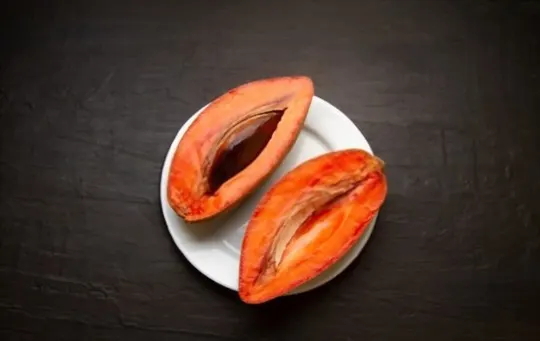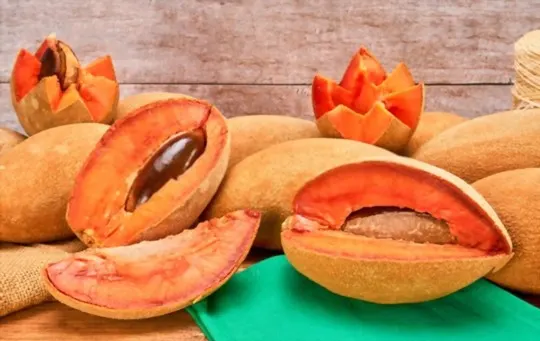Have you ever heard of a mamey?
Though not as well-known as its cousins the avocado, banana and pineapple, the mamey fruit has been gaining in popularity over recent years.
This delicious tropical superfood is known for its powerful nutritional properties, unique flavor profile and numerous health benefits but what does all this mean exactly?
What does mamey taste like and how can it improve your diet and overall wellbeing?
Well if that’s what you’ve been wondering about this versatile flavor bomb destination then you have come to the right place!
In this comprehensive guide we will take an in depth look at what makes mamey special so get ready to discover why foodies everywhere are going crazy for this totally tasty treat!
What is Mamey?

Mamey is a tropical fruit that is native to Central and South America, particularly Mexico, Belize, and Guatemala.
It has a brown, rough, and slightly fuzzy skin with a bright orange flesh inside.
Mamey belongs to the same family as sapotes and persimmons and is an excellent source of fiber, vitamins A and C, iron, potassium, and magnesium.
In terms of its appearance, mamey has a unique oval shape with an average weight of about one pound.
The texture of the fruit is creamy and smooth when ripe.
When cut open, it reveals a dark brown seed that should be removed before consumption.
Mamey is consumed in various ways throughout Latin America.
In some countries like Mexico, it’s used to make a popular ice cream flavor called “helado de mamey.
” It’s also blended into smoothies or made into a refreshing agua fresca beverage.
Some people eat it raw by slicing it or scooping the flesh out with a spoon.
Mamey can be found at specialty markets in countries where the fruit grows natively or imported by some countries on rare occasions.
If you happen to come across this exotic fruit at your local market, don’t hesitate to give it a try.
What Does Mamey Taste Like?

Mamey is a tropical fruit that is native to Central and South America.
It has a unique taste that is difficult to describe but has been compared to a mix of sweet potato, pumpkin, and peach.
The texture is similar to an avocado or custard apple with a soft, creamy flesh.
When you take a bite of mamey, the first thing you’ll notice is its sweetness.
However, it’s not overly sweet like some fruits can be.
Instead, it has a subtle sweetness that is balanced out by its earthy and nutty flavors.
Some people also say they taste hints of caramel or brown sugar in each bite.
Overall, mamey has a very rich and flavorful taste that many people enjoy.
If you’re used to eating more traditional fruits like apples or strawberries, mamey may take some getting used to due to its unique flavor profile.
If you’re ever lucky enough to try fresh mamey, there are several factors that can affect its taste.
For example, how ripe the fruit is will impact its sweetness level and overall taste.
The climate where the fruit was grown can also play a role in how intense the flavors are.
Factors that Affect the Taste of Mamey

The taste of mamey can vary depending on a few factors.
Here are some things that can affect the overall flavor profile of this tropical fruit:
- Maturation – The ripeness of the mamey fruit plays a huge role in its flavor profile. As it matures, it becomes sweeter and creamier.
- Growing conditions – The climate and soil where the mamey tree is grown affects its taste. Mamey grown in tropical areas tend to have a more intense, fruity flavor than those grown in slightly cooler climates.
- Processing methods – When mamey is turned into juice or other products, additives or processing techniques can alter the taste considerably.
- Genetics – Just like with any fruit or vegetable, different varieties of mamey will have their own unique flavors.
- Rarity – In some places, mamey is considered a rare delicacy. Due to its scarcity, it may be priced higher and sought after for its novelty, which can make it taste even better.
Considering these factors, you can see why mamey isn’t just one simple flavor but rather a complex mix of several different elements.
It’s interesting to compare different types of mameys from around the world to see how their flavors differ depending on where they’re grown.
Overall, understanding these factors that affect the taste of mamey will give you a better appreciation for this delectable fruit’s diverse properties.
Culinary Uses of Mamey
Mamey is a versatile fruit that can be used in many different culinary applications.
It has a sweet, creamy flesh and a unique flavor that pairs well with a variety of ingredients.
One of the most popular uses for mamey is in smoothies and milkshakes.
The fruit adds an extra dimension of creaminess and sweetness, which complements the other flavors in these drinks.
Another popular use for mamey is in desserts such as ice cream, sorbet, and pastry fillings.
Its natural sweetness makes it an ideal ingredient for desserts, while its creamy texture creates a smooth consistency that is perfect for frozen treats.
In addition to desserts and drinks, mamey can also be used in savory dishes such as salsas and marinades.
Its slightly tropical flavor profile works well with seafood, poultry, and pork dishes, adding a touch of sweetness to balance out bold seasonings and spices.
Overall, mamey is a versatile ingredient that can be used in many different culinary applications.
Its unique flavor profile makes it an interesting addition to both sweet and savory dishes alike.
Where to Buy Mamey and How to Store It?

If you’re looking to buy mamey, you can visit your nearest Latin American market or specialty grocery store.
Mamey is a popular fruit in many countries like Mexico, the Caribbean, and Central and South America, so it should not be too difficult to find.
Look for fruits that are free from bruises and have an even, firm texture.
Mamey should also give off a sweet aroma.
Once you have purchased your mamey, it is important to store it properly.
The fruit does not ripen on the tree but rather once it has been picked.
If the fruit is not ripe when you purchase it, store it at room temperature until it softens up.
Once the fruit is ripe, place it in the refrigerator to prolong its freshness.
To summarize, if you want to try mamey, visit a local Latin American market or specialty grocery store and choose fruits that are firm and do not have any bruises.
Mamey should smell sweet and must be stored at room temperature until fully ripened before placing in the fridge for longer-lasting freshness.
Conclusion
Mamey is a fruit that is not commonly found in most supermarkets, but it is available in some specialty stores and online.
If you are looking to try this unique fruit, be sure to do your research and find a reputable seller.
Once you have found a source for mamey, it is important to store it properly.
In terms of flavor, mamey has been described as sweet and creamy with hints of pumpkin, sweet potato, and almond.
Some people compare its texture to that of an avocado or mango.
Overall, mamey has a unique flavor profile that many people find enjoyable.

What Does Mamey Taste Like? A Comprehensive Guide
Ingredients
- Mamey
- Ingredients from your selected recipes
Instructions
- Select ingredients that work well together.
- Use a recipe or method that will enhance their natural taste.
- Taste and adjust the recipe as needed to achieve the desired flavor.

Carrie is a food writer and editor with more than 15 years of experience. She has worked for some of the biggest names in the food industry, including Bon Appétit, Food & Wine, and Martha Stewart Living.
As the Editor in Chief of IntroChicago.com, Carrie oversees all of the content on the site. She also manages the team of contributing writers and editors, who help to create delicious recipes, helpful tips, and informative articles that you’ll find on the site.
A native of the Chicago area, Carrie is passionate about all things food. She loves trying new restaurants and experimenting with new recipes in her kitchen. She’s also a graduate of the Culinary Institute of America, so she knows a thing or two about food!
